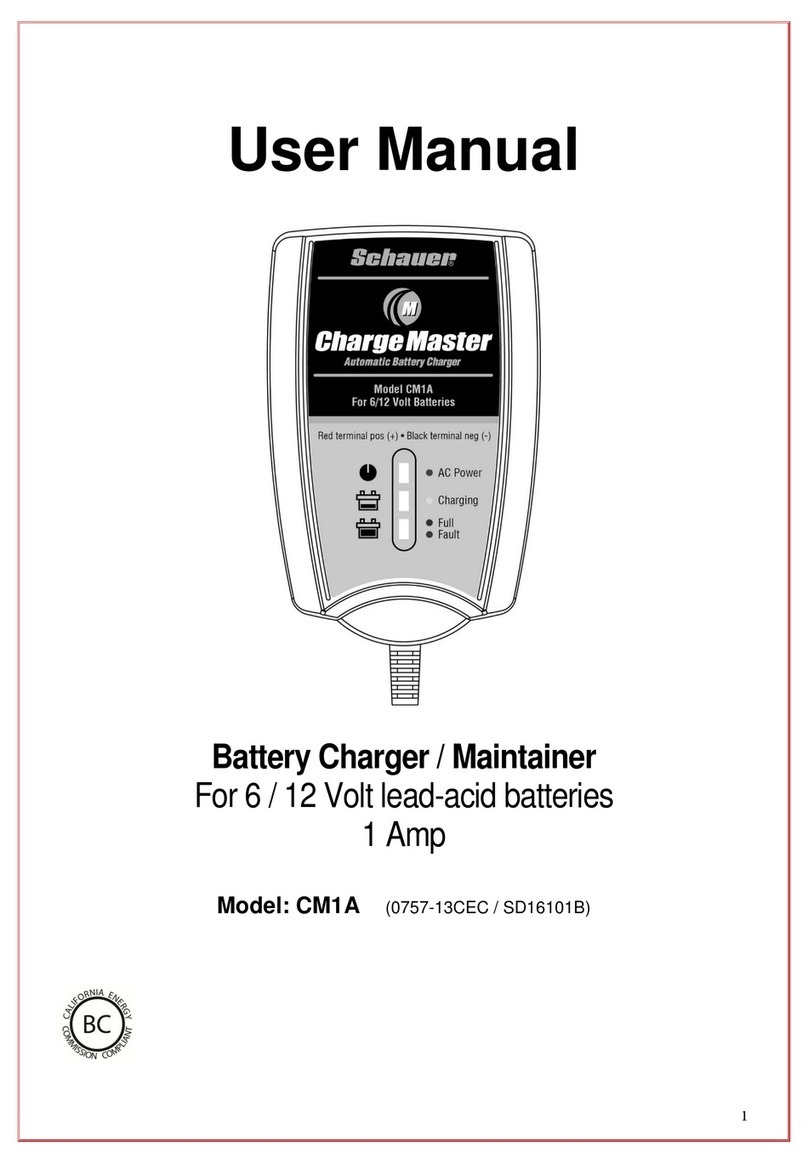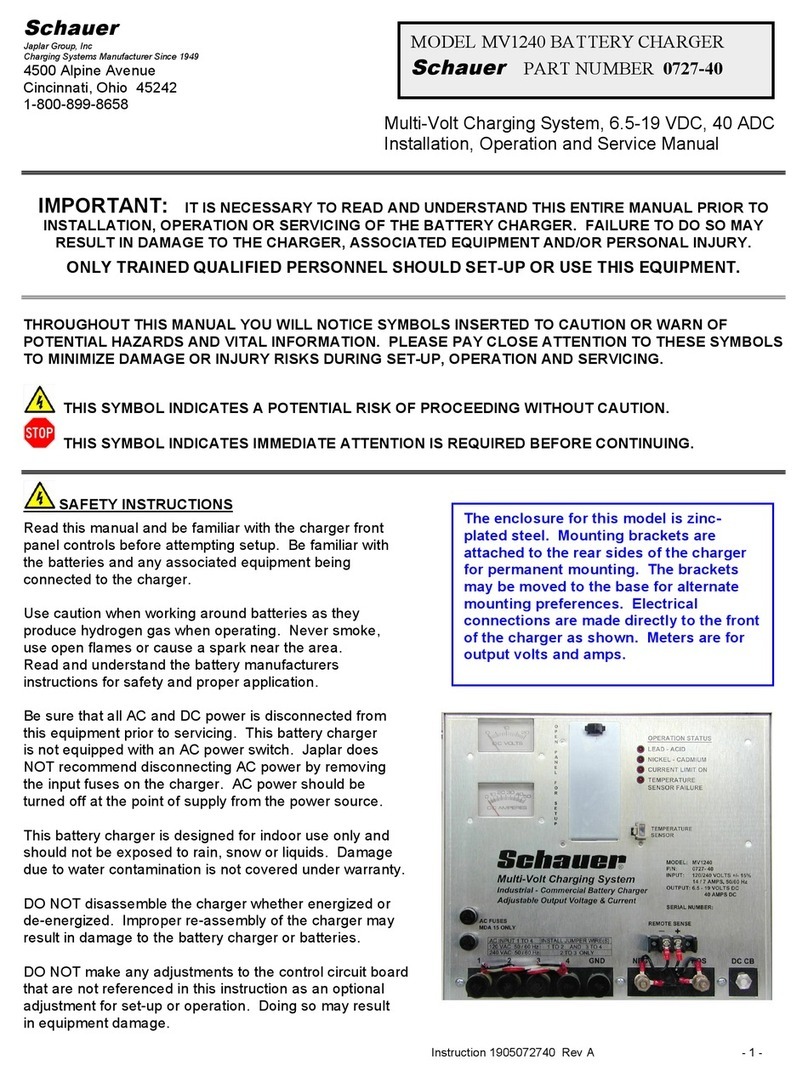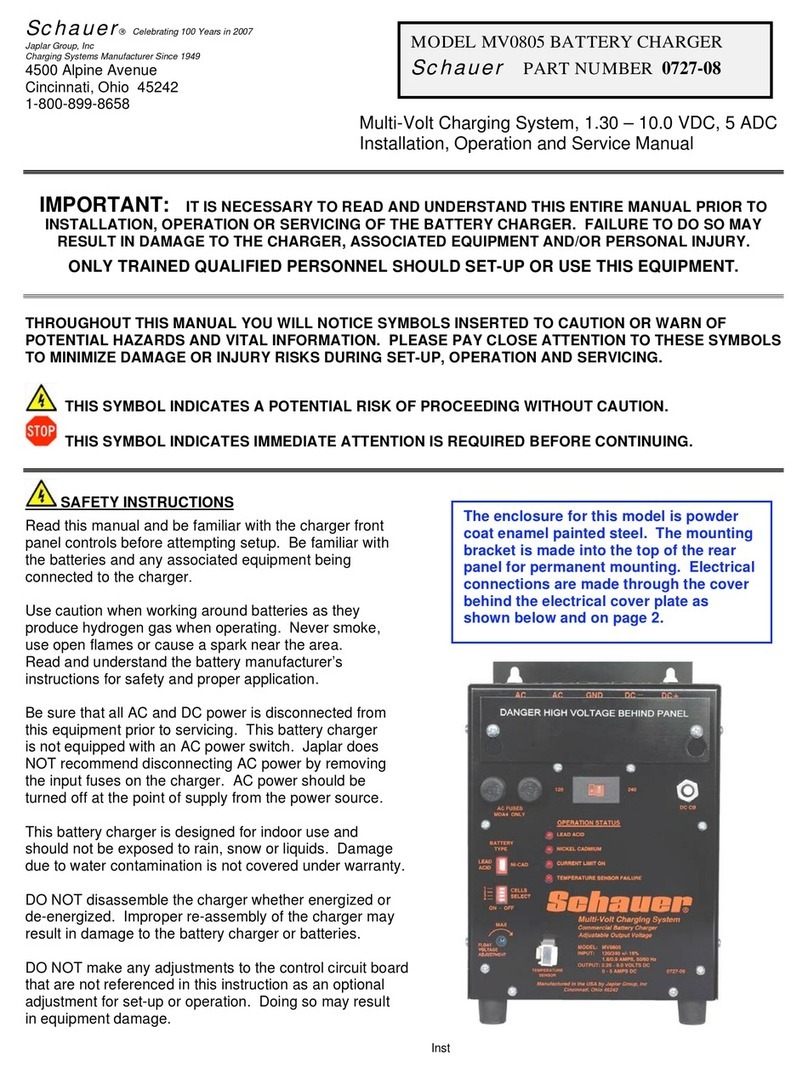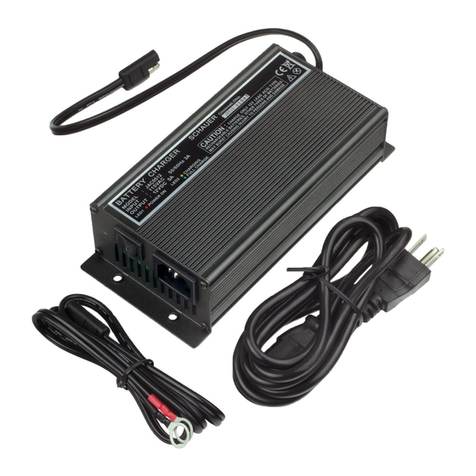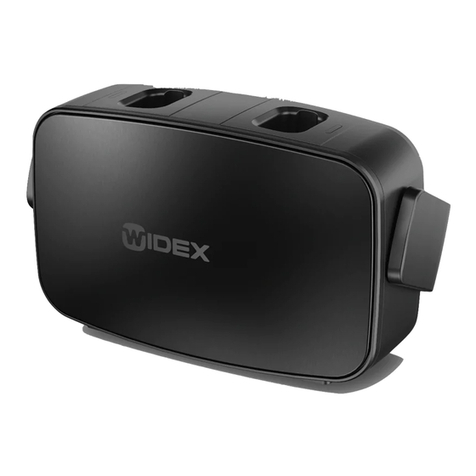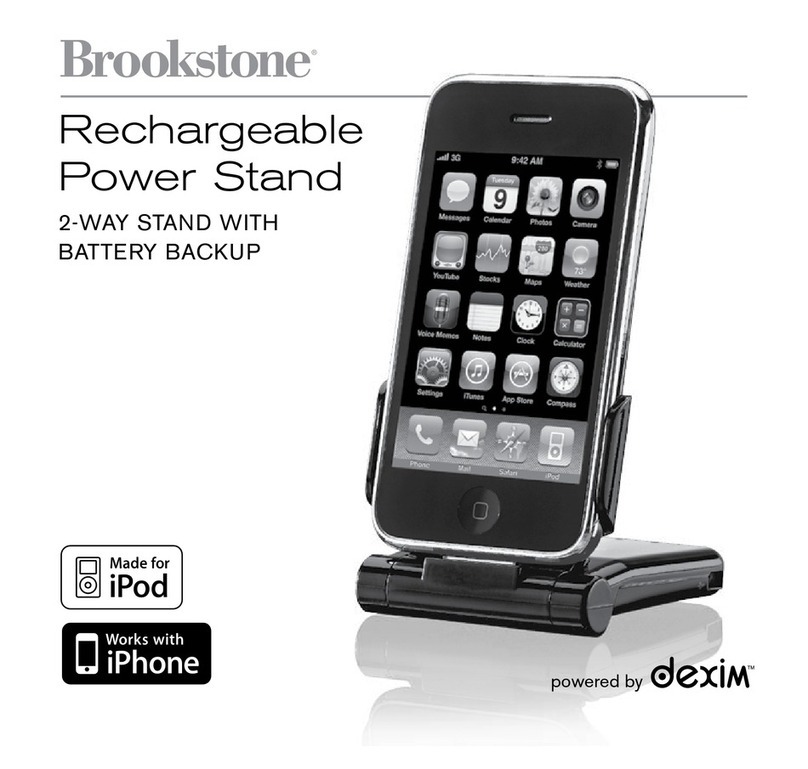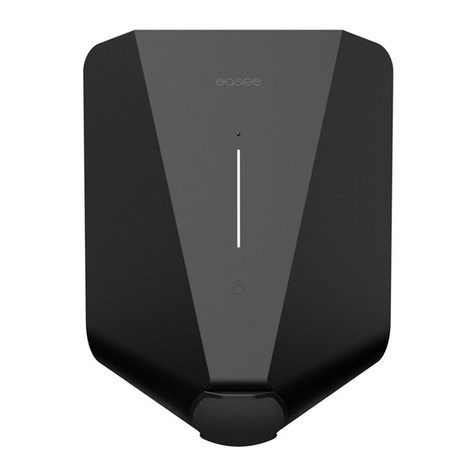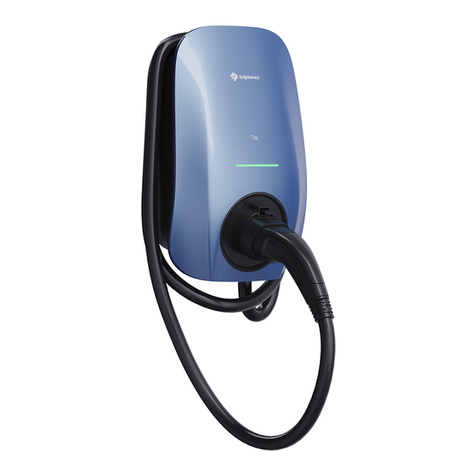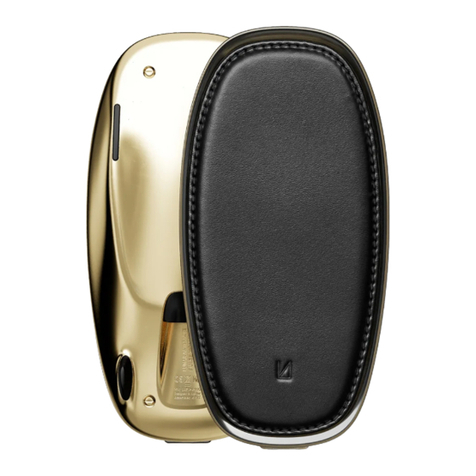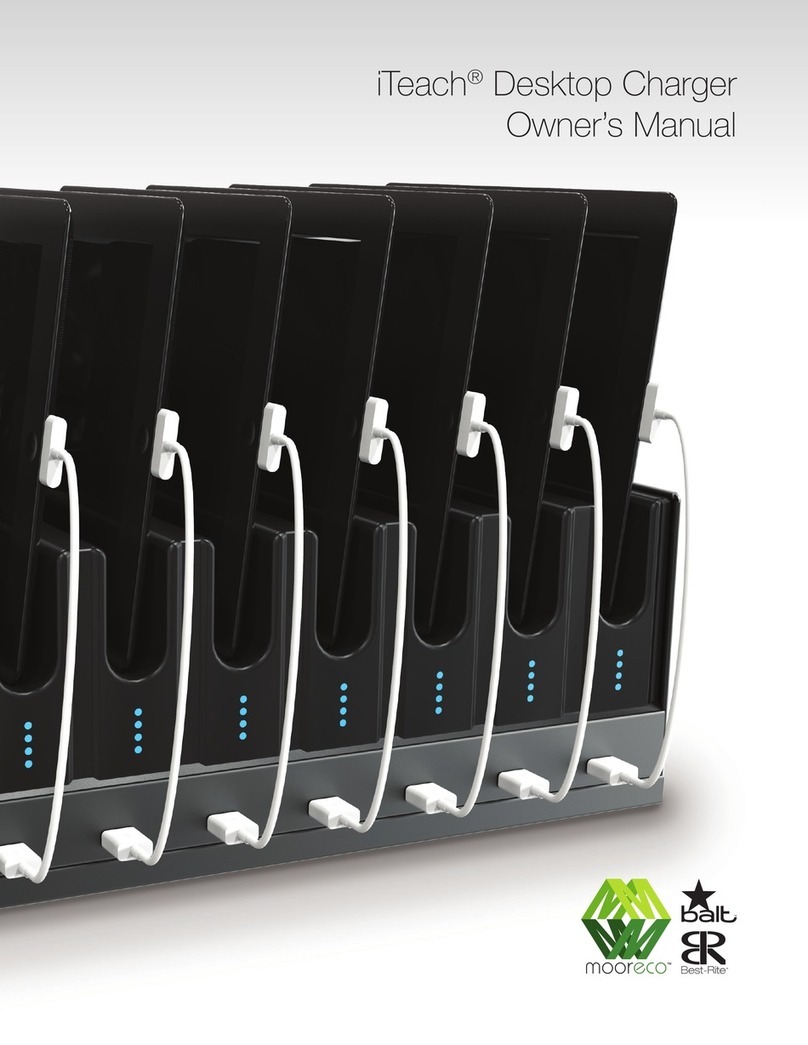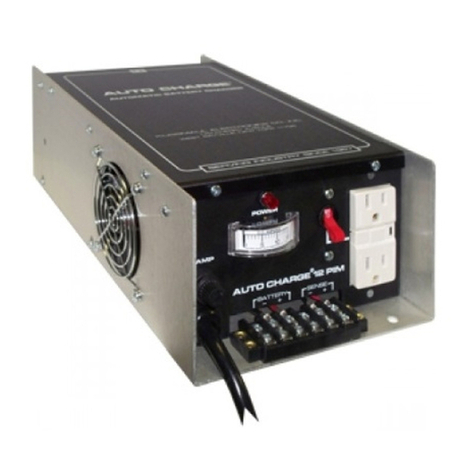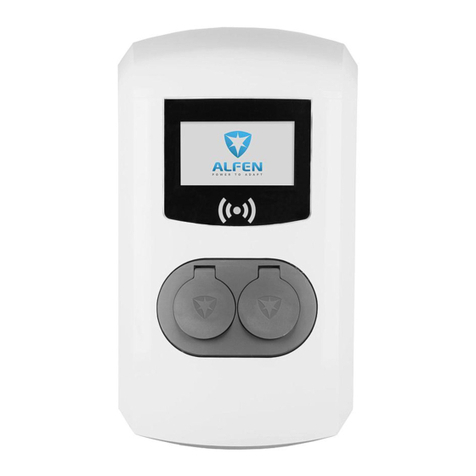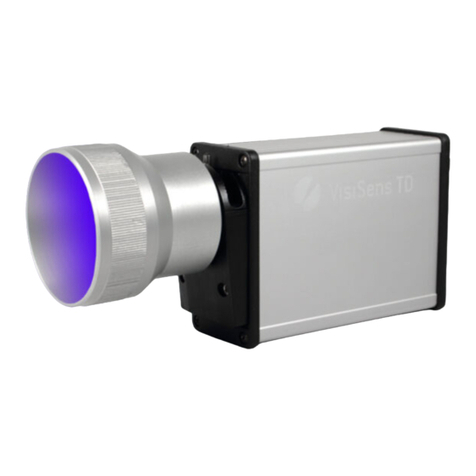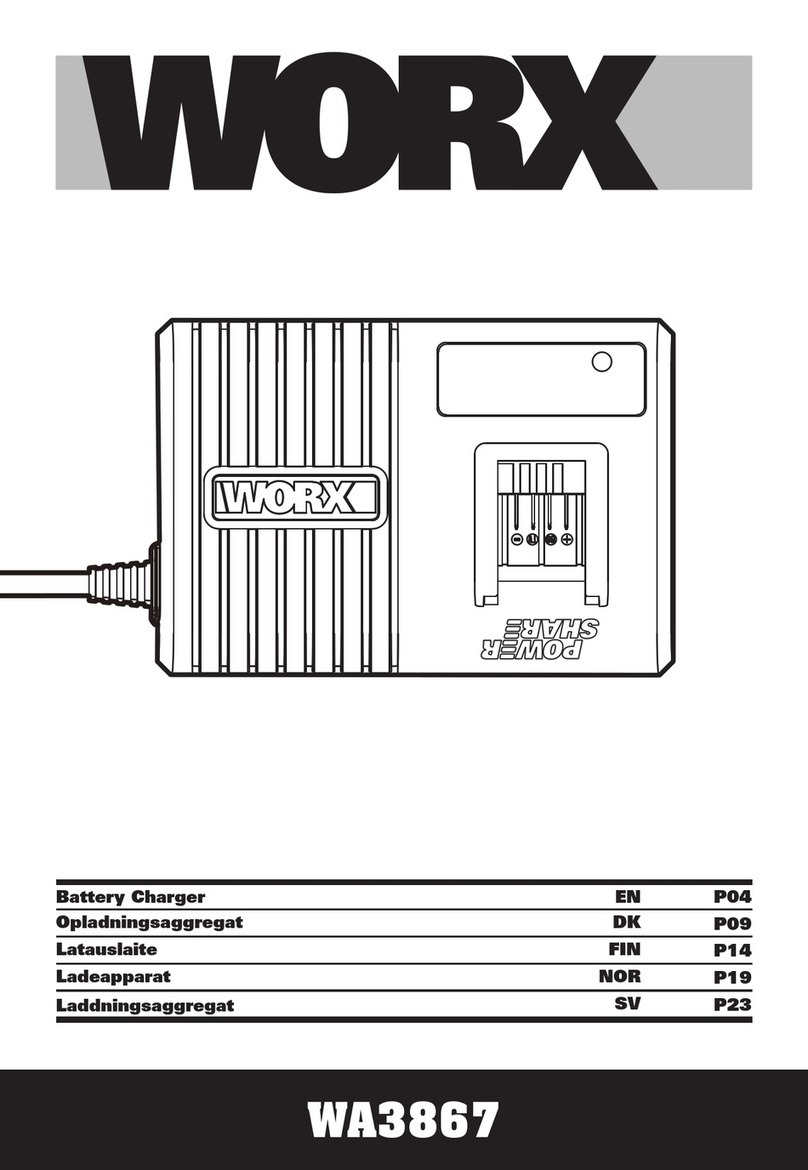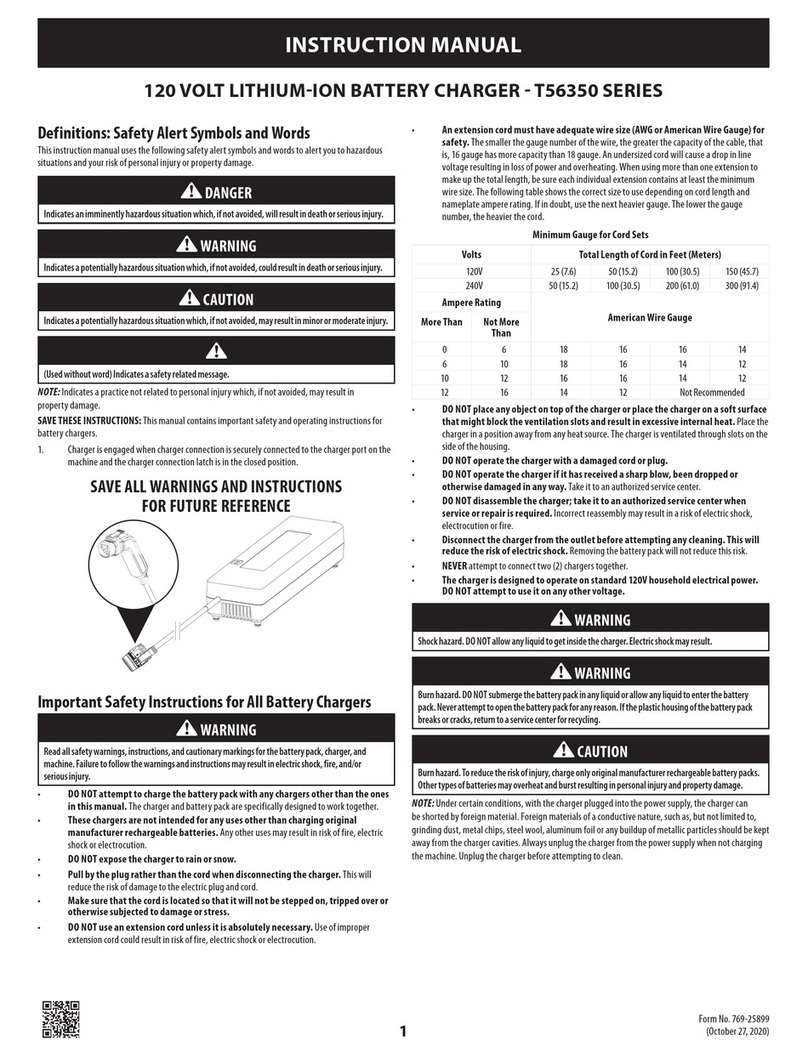Schauer M690 User manual

1
Batteries generate explosive hydrogen gas, even during normal operation.
Peoplehavebeeninjuredbybatterypartsflyinginanexplosion.Theycanexplode
under normal operating conditions, such as starting your car. They can explode
under abnormal conditions, such as jump starting, or if short circuited by a tool.
They can explode in a parked car or sitting on a table.
To help reduce the risk of these dangers and injury, it is of the utmost importance
that each time before using your charger, you read and understand this manual,
and any warnings and instructions by the battery manufacturer. Follow these
instructions exactly.
TO HELP REDUCE THIS RISK:
1. Wear Personal Protective Equipment
•ALWAYSwearcompleteeyeprotection(THATPROTECTSEYESFROMALL
ANGLES).
2. Avoid Flames and Sparks Near Battery and Fuel
•ALWAYS keep flames, matches, lighters, cigarettes or other ignition sources
away from battery.
•DO NOT put flammable material on or under charger. DO NOT use near
gasoline vapors.
•ALWAYS plug charger into an electrical outlet AFTER all connections have
been made..
•Atool touchingboth batteryposts orbattery postand carmetal partsis ashort
circuitand will spark.Whenusing metaltoolsonor nearbatterybeextra cautious
toreduce riskof shortcircuit,possibly causinga batteryexplosion.DO NOT drop
a tool on battery.
3. Reduce Explosive Gas (hydrogen)
•Before connecting charger, ALWAYS add water to each cell until battery acid
covers plates to help purge extra gas from cells. DO NOT overfill. Battery acid
expandsduringcharge.Afterchargingfilltolevelspecifiedbybatterymanufacturer.
Fora batterywithout removable caps(maintenance freebattery), carefully follow
manufacturer's instructions on charging.
•Some sealed maintenance free batteries have a battery condition indicator. A
lightorbrightcoloreddotindicateslowwater.Suchabatteryneedstobereplaced,
not charged or jump started.
•Charge battery with caps in place. Most U.S. batteries are made with flame
arrestingcaps.DONOTprycapsoffsealedbatteries.Placewetclothonbatteries
with non-flame arresting caps.
•Be sure area around battery is well ventilated before and during charging
process. NEVER charge in a closed-in or restricted area.
4. Stay Away From Battery When Possible
•NEVER put face near battery.
•ALWAYS locate charger as far from battery as DC cables permit.
•ALWAYS keep other people away from the battery. They are not wearing
safety glasses like you are.
5. Avoid Contact With Battery Acid
•Battery posts may have acid corrosion. DO NOT get corrosion in your eyes.
Avoid touching eyes while working near battery.
•ALWAYS use a battery carrier. Carrying a battery by hand may put pressure
on its ends, causing acid to be forced out vent caps.
•ALWAYS have plenty of fresh water and soap nearby in case battery acid
contacts eyes, skin or clothing. If battery acid contacts skin or clothing, wash
immediately with soap and water. If acid enters eye, immediately flood eye with
cold running water for at least fifteen (15) minutes and get medical help
immediately.
•Inverycoldweatheradischargedbatterymayfreeze.NEVERchargeafrozen
battery. Gases may form, cracking the case, and spray out battery acid.
6. Avoid Overcharging Batteries
•The nonautomatic (manual) battery charger model can overcharge a battery
if left connected for an extended period of time, resulting in loss of water and
creation of hydrogen gas.
7. Follow Other Manufacturers' Recommendations
•Before using charger, read all instructions for, and caution markings on: (1)
charger, (2) battery, and (3) related product using battery. Follow their
recommended rate of charge.
R
M690 BATTERY CHARGER
OPERATING INSTRUCTIONS
SAVE THESE IMPORTANT SAFETY INSTRUCTIONS
BATTERYWARNINGS
DANGER!
RISK OF BATTERY EXPLOSION FROM HYDROGEN GAS. MAY RESULT
IN BLINDNESS, SERIOUS INJURY, PERMANENT DISFIGUREMENT AND
SCARRING.
ELECTRICAL WARNINGS
DANGER!
RISK OF ELECTRICAL AND FIRE HAZARD. MAY RESULT
IN DEATH, SERIOUS INJURY, SHOCK OR BURNS.
TO HELP REDUCE THIS RISK:
This charger, like all electrical products, MUST be treated with respect. Follow
these instructions to reduce electrical hazard risk.
DANGER! DC VOLTAGES ABOVE 48 VOLTS ARE DEADLY. TO REDUCE
THE RISK OF ELECTROCUTION DO NOT TOUCH UNINSULATED PARTS
OFBATTERYTERMINALSORWIRINGWHENCONNECTINGORCHARGING
A NUMBER OF BATTERIES CONNECTED IN SERIES..
1. PROPER GROUNDING AND AC POWER CONNECTION
•Charger MUST be grounded to reduce risk of electric shock. Charger is
equipped with an electric cord having an equipment grounding conductor and a
grounding plug. The plug MUST be plugged into an outlet that is properly
installedandGROUNDEDinaccordancewithalllocalcodesandordinances.
Ifyoueverfeelevenaslightshockfromthisoranyelectricalappliance,stop,walk
away. Turn off electricity to outlet, and have it inspected by an electrician. You
may have a dangerous, improperly wired outlet.
•DANGER-NEVERalterACpowercordorplugprovided- if it willnot fit outlet,
have proper outlet installed by a qualified electrician or proceed as shown in the
illustration below. Improper connection can result in a risk of an electric shock.
This battery charger is for use on a nominal 120 volt circuit (common household
current), and has a grounding plug as illustrated. A temporary adapter may be
used, USA only, to connect this plug to a two-pole receptacle, as shown, if
properlygroundedoutletisnotavailable.The temporary adaptershould beused
only until a properly grounded outlet can be installed by a qualified electrician.
•DANGER - Before using adapter as illustrated below, be certain that center
screw of outlet plate is grounded. The green colored rigid ear or lug extending
from adapter MUST be connected to a properly grounded outlet - make certain
it is grounded. If necessary, replace original outlet cover plate screw with a
longer screw that will secure adapter ear or lug to outlet cover plate and make
ground connection to grounded outlet.
2. Remove Jewelry
•ALWAYS remove personal metal items (such as rings, bracelets, necklaces
and watches) when working with a battery. A short circuit through one of these
items can melt it causing a severe burn.
;;;;;
;;;;;
ALWAYS assume that any
battery might explode
when you least expect it.
Wear safety glasses for
your protection.

2
•To reduce risk of damage to plug and cord when disconnecting charger,
ALWAYS pull on plug - NEVER on cord.
•Locatecordsothat itwillnotbesteppedon,trippedover,orotherwisesubject
to damage or stress. DO NOT lay extension cord on battery or charger.
•DONOT operate charger with damaged cord or plug - replace them
immediately.
•Determine battery voltage by referring to vehicle or equipment owner's
manual and make sure it matches DC output voltage shown on charger
nameplate.
•This battery charger is designed specifically for charging automotive lead-
acid batteries. DO NOT use with dry-cells that are commonly used with home
appliances, flashlights, etc. These batteries may burst and cause injury to
persons and damage to property.
•Thischargerisnotintendedtosupplylow-voltagepowerforapplicationsother
than battery charging.
•Chargingabatteryonboardaboatfloatinginwaterrequiresabatterycharger
specially designed to marine charging standards. Move the battery to dry land
for charging with this charger.
GENERAL INFORMATION
•ModelM690isamulti-celllead-acidbatterychargerfor charging 1to 36 cells.
Any combination of 2, 6, 8, 12, or 24 volt batteries connected in series, up to a
maximum of 72 volts can be charged at any rate between 0 and 6 amps DC. It
is suitable for use on conventional, low maintenance and maintenance-free
batteries.
•TheM690IS NOT anautomatic batterycharger andcan over-chargeiflefton
too long or at too high of a charge rate.
•WARNING: Some parts used in the M690 tend to produce arcs and sparks
and therefore, if used in a garage, should be located in a room or enclosure
specifically for charging or placed not less than 18" above the floor.
•The charger does not have to be disconnected from the battery(s) if the AC
power is turned off.
•TheM690isequippedwithamanualresetACcircuitbreakerandaDCoutput
fuse to protect the charger and/or battery(s). DO NOT replace the output fuse
with any other rating or use a time delay type fuse. This will void the warranty.
Refer to the “Problem Checklist” section for troubleshooting tips.
•Caution: Setting the charge rate to greater than 6 amps may damage the
charger.
•Sincebatterycharginginstallationsvary,theM690issuppliedwithapolarized
DCoutput plugwith 6"lead andwire connectorsfor connectingto yourcharging
cables. See Figure 1.
DANGER! SHOCK HAZARD: DO NOT OPERATE THE M690 UNTIL IT IS
PROPERLY CONNECTED. as below.
3. Avoid Charger Abuse
•To reduce risk of electric shock, unplug charger from outlet before attempting
any maintenance or cleaning. Turning off controls will not reduce this risk.
•DO NOT disassemble charger. Take it to a qualified service person when
service or repair is required. Incorrect reassembly may result in a risk of electric
shock or fire.
•DO NOT expose charger to rain, snow, water, gas, oil, etc.
•DO NOT operate charger if it has received a sharp blow, been dropped, or
otherwise damaged in any way; take it to a qualified service person.
•DO NOT block air holes in top or bottom of charger. DO NOT put charger on
vehicle seat. DO NOT set a battery on top of charger.
•DO NOT operate charger with clips shorted together.
•The polarity of the charger and the battery MUST ALWAYS match to avoid
damage to battery and charger.
4. Proper Use of Charger and Wiring
•An extension cord should not be used unless absolutely necessary. Use of
improper extension cord could result in a risk of fire and electric shock. If
extension cord must be used, use ONLY a grounded, 3-wire type cord. NEVER
use a 2-wire cord and an adaptor! The cord MUST be plugged into a grounded
outlet. Make sure it is properly wired, in good electrical condition, and wire size
is large enough for AC ampere rating of charger as specified below. AWG =
American Wire Gauge
Grounding Plug
with
Grounding Pin
Grounding Means
Adapter
USA ONLY
Grounded Outlet Two conductor Outlet
Center screw MUST be grounded
Grounded
center
screw
Using an adapter is
forbidden
in Canada. If a grounded
outlet is not available, have one installed by a qualified
electrician before using this charger.
Length of Cord (feet) 25 50 100 150
Wire Size of Cord (AWG) 18 16 12 10
You may use heavier size wire — NEVER lighter.
RECOMMENDED PROPER WIRE SIZE (AWG) IN
EXTENSION CORDS FOR BATTERY CHARGERS
•DO NOT modify charger circuitry.
Figure 1

3
Operating Instructions
TURNING THE CHARGER ON
•Make sure the charge rate control is set to the MINIMUM position
and the AC and DC switches are OFF before connecting AC line cord
to 120 volt outlet.
•Connect the charger plug to the battery plug.
•Turn DC switch ON.
•Turn AC switch ON.
•Rotate control clockwise until the ammeter shows the desired charge
rate. DO NOT EXCEED 6 AMPS.
•During the charging period the M690 charge rate control can be
adjusted to maintain 6 amps if desired. Check periodically for full
charge by:
A) Specific Gravity measurements of battery acid, or
B) Observing when battery acid begins a gentle bubbling action, or
C) Checking built-in charge indicator on totally sealed batteries.
D)Measuringthebatteryvoltagestoppingatthebatterymanufacturerssuggested
end point. SPECIFIC GRAVITY PERCENT OF
(AVERAGE OF ALL CELLS) CHARGE
1.265 - 1.285* 100
1.225 75
1.190 50
1.155 25
1.120 0
* A battery with sulphated plates will not reach this level and continued charging
will result in overcharging and excessive water loss.
TURNING THE CHARGER OFF
When charging is completed:
•Rotate control to the MINIMUM position.
•Turn AC switch to OFF.
•Turn DC switch to OFF.
•Unplug AC cordset.
•Disconnect charger plug from battery plug.
TROUBLE SHOOTING
1. IF THERE IS NO CHARGER OUTPUT:
A) Make sure DC switch is ON.
B) Make sure AC switch is ON.
C) Unplug charger AC plug and check battery connections.
D) Check for 120 volts at the AC outlet.
E) Check the charger DC fuse.
F) Check for tripped AC circuit breaker on the battery charger.
NOTE: If the AC breaker trips repeatedly without exceeding
the 6 amps charge rate, have the charger checked by a
qualified technician.
STORAGE
Clean clips. Repack charger and instruction manual. Store in a dry place not
subjecttosubzerotemperatureswhichcouldcausethecordinsulationtobecome
stiff and possibly crack when uncoiled.
1902022826 rev B
Copyright 2007 Japlar Group; Cincinnati, Ohio 45242, USA www.battery-chargers.com
TWO YEAR LIMITED WARRANTY
JAPLARGroup,Inc.,(hereinafter“JAPLAR”),herebywarrantstotheOriginalConsumerPurchaser,subjecttotheconditionssetforthbelow,thatitwillrepairorreplace
(atJAPLAR’soption)theproductoranypartthereofwhichprovesdefectivebyreasonofimproperworkmanshipormaterialforaperiodoftwo(2)yearsfromtheoriginal
purchase date without charge for parts or labor. “Product” includes battery chargers, test instruments and recreational vehicle accessories and all component parts
thereof.
1. Original Consumer Purchaser. This limited warranty is extended only to the original purchaser who intends to initially use the product and is not extended to any
other party.
2. This limited warranty shall not apply to:
a. Any product or part thereof that has been damaged by alteration or by repair or service not rendered by JAPLAR or by
a JAPLAR authorized repair station.
b. Any product or part thereof that has been subject to accident, misuse, abuse, or operated contrary to JAPLAR’s instructions pertaining to the product.
3. To obtain warranty repairs, the product should be carefully packaged and delivered, postage or delivery charges prepaid, to JAPLAR Group, Inc., 4500 Alpine
Avenue,Cincinnati,Ohio45242,ortoaJAPLARauthorizedrepairstation.Ifwithinthecoverageofthislimitedwarrantythereplacedorrepairedproductwillbereturned
to the Original Consumer Purchaser at JAPLAR’s expense.
4. Any Implied Warranty of Merchantability or Fitness for a Particular Purpose is Limited to a Period of Two Years From the Original Purchase Date. Some States Do
Not Allow Limitations on How Long an Implied Warranty Lasts, So the Above Limitation May Not Apply to You.
5. JAPLAR will not be responsible for any loss or damage to person or property, or lost profits or other similar loss or damage which may result or be claimed to have
resulted from a defect in workmanship or material of any product. Some states do not allow the exclusion or limitation of incidental or consequential damage, so the
above limitation or exclusion may not apply to you.
6. JAPLAR neither assumes nor authorizes any representative or other person to assume for it any obligation or liability other than those expressly set forth herein.
7. This warranty gives you specific legal rights, and you may also have other rights which vary from state to state.
Table of contents
Other Schauer Batteries Charger manuals
